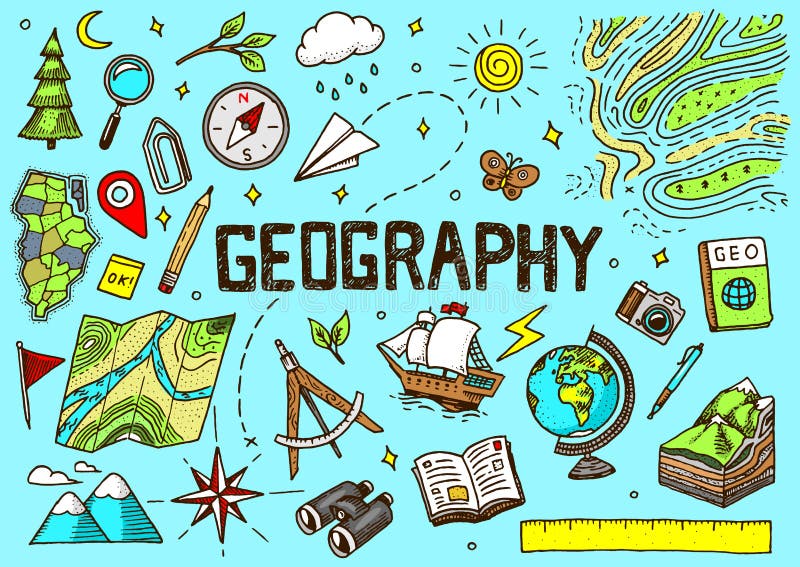2025 /2026 JAMB CBT GEOGRAPHY Syllabus is Out: Get Ready to Excel in UTME

Are you preparing for the 2025 Unified Tertiary Matriculation Examination (UTME)? Great news! The official 2025 JAMB CBT syllabus has been released, and you’re at the right place to get all the details you need to succeed. This syllabus is your ultimate guide to understanding each subject’s topics, objectives, and expectations.
OBJECTIVES OF GEOGRAPHY JAMB SYLLABUS
1. handle and interpret topographical maps, photographs, statistical data and diagrams and basic field survey;
2. demonstrate knowledge of man’s physical and human environment and how man lives and
earns a living on earth surface with special reference to Nigeria and Africa;
3. show understanding of the interrelationship between man and his environment;
4. apply geographical concepts, skills and principles to solving problems;
5. understand field work techniques and the study of a local area in the field.
RECOMMENDED TEXTS
Adeleke, B.O. Areola .O. 2002 and Leong, G.C.Certificate Physical and Human Geography for Senior Secondary
School(West African Edition), Ibadan: Oxford.
Balogun, O.Y. (2009) Senior Secondary Atlas, Nigeria: Longman, Nigeria.
Bradshaw, M. et al (2004) Contemporary World Regional Geography, New York: McGraw Hill.
Bunet, R.B and Okunrotifa, P.O.(1999) General Geography in Diagrams for West Africa, China: Longman.
Collins New Secondary Atlas, Macmillan.
Emiela, S.A. (2014) Senior Secondary Geography (New Syllabus Edition), Geographical Bureau Nig. Ltd.
Fellman, D. et al (2005) Introduction to Geography (Seventh Edition) New York: McGraw Hill.
Getis, A. et al (2004) Introduction to Geography (Ninth Edition) New York: McGraw Hill.
Iloeje, N. P(1999) A New Geography of West Africa, Hong Kong: Longman.
Iloeje, N.P(1982) A New Geography of Nigeria (New Education), Hong Kong: London.
Iwena, O.A. (2018) Essential Geography for Senior Secondary Schools. Ibafo, Nigeria: Tonad Publishers Limited.
Nimako, D.A. (2000) Map Reading of West Africa, Essex: Longman.
Okunrotifa, P.O. and Michael S. (2000) A Regional Geography of Africa (New Edition), Essex: London.
Udo, R.K(1970) Geographical Regions of Nigeria, London: Longman.
Waugh, D. (1995) Geography an Integrated Approach (Second Edition), China: Nelson.
Wisdomline Pass at Once JAMB.
Adegoke, M.A (2013),A Comprehensive Text on Physical, Human and Regional Geography.
WHY YOU NEED JAMB GEOGRAPHY SYLLABUS
Are you preparing for the 2025 JAMB Geography exam? If yes, then the JAMB Geography syllabus is a must-have! Here’s why:
A Clear Study Guide
The syllabus outlines all the topics JAMB expects you to study, helping you focus on what truly matters for the exam.
Saves Time & Effort
Instead of studying random topics, the syllabus ensures you only cover areas that will be tested, making your preparation efficient and effective.
Boosts Your Confidence
Knowing what to expect in the exam helps you prepare properly, reducing exam anxiety and making you more confident on the big day.
Covers Key Topics & Objectives
The syllabus highlights important areas like map reading, environmental geography, human and physical geography, ensuring you don’t miss any crucial concepts.
Helps You Track Your Progress
With the syllabus, you can check off topics as you study, making sure you’re fully prepared before the exam.
Increases Your Chances of Scoring High
When you study using the syllabus and practice past questions, you align your preparation with JAMB’s expectations, increasing your chances of success.
Get the 2025 JAMB Geography Syllabus Today for free !
Don’t waste time studying irrelevant topics—use the JAMB Geography syllabus as your study roadmap and get ahead in your UTME preparation!
Using Examscholars it will help you stay organized, study smarter, and ultimately excel in your UTME exam!
SCORE ABOVE 300 WITH EXAMSCHOLARS
Are you preparing for JAMB UTME and looking for the best way to practice and pass excellently? ExamScholars CBT App is your ultimate solution! Say hello to , the app designed to help students like you excel and become a pro in no time!
Why You Need ExamScholars CBT App to Ace Your JAMB Geography Exam
Are you preparing for the 2025 JAMB Geography exam? Then you need the ExamScholars CBT App to practice effectively and score high! Here’s why:
Real JAMB Standard Questions
Get access to past and likely JAMB questions that are set exactly like the real exam, helping you get familiar with the question format.
Covers the Entire Syllabus
The app is designed to follow the JAMB Geography syllabus, so you only practice relevant topics—no wasted time on unnecessary content!
Instant Feedback & Explanations
After every question, you get detailed explanations on why the answer is correct, helping you understand concepts better and avoid mistakes in the real exam.
Timed Practice & Exam Simulation
The app lets you practice under real exam conditions, improving your speed and accuracy so you can finish on time during the actual UTME.
Track Your Progress
Know your strengths and weaknesses with performance tracking, so you can focus on areas that need improvement.
Study Anytime, Anywhere
No need for bulky textbooks—practice anytime with just your phone or tablet, making studying more convenient.
Get the ExamScholars App Today & Start Practicing Like a Pro!
Don’t just study—practice smart with ExamScholars CBT App and boost your chances of scoring high in JAMB Geography!
DETAILED 2025/2026 ECONOMICS JAMB SYLLABUS
1. Economics as a science
a. Basic Concepts:
wants, scarcity, choice, scale of
preference, opportunity cost, rationality,
production, distribution, consumption.
b.(i) Economic problems of:
what, how and for whom to produce and
efficiency of resource use.
b.(ii)Application of PPF to solution of economic
problems.
2. Economic Systems
a. Types and characteristics of free
enterprise, centrally planned
and mixed economies
b. Solutions to economic problems under
different systems
c. Contemporary issues in economic systems
(economic reforms e.g deregulation,
banking sector consolidation, cash policy
reform).
3. Methods and Tools of Economic Analysis
a. Scientific Approach:
i. inductive and deductive methods
ii. positive and normative reasoning
b. Basic Tools
i. tables, charts and graphs
ii. measures of central tendency: mean,
median and mode, and their
applications.
iii. measures of dispersion; variance,
standard deviation, range and their
applications;
iv. merits and demerits of the tools.
4. The Theory of Demand
a. i. meaning and determinants of demand
ii. demand schedules and curves
iii. the distinction between change in
quantity demanded and change in
demand.
b. Types of demand:
Composite, derived, competitive and
joint demand:
c. Types, nature and determinants of
elasticity and their measurement –
price, income and cross elasticity of
demand:
d. Importance of elasticity of demand to
consumers, producers and government.
5. The Theory of Consumer Behaviour
a. Basic Concepts:
i. utility (cardinal, ordinal, total
average and marginal utilities)
ii. indifference curve and budget
line.
b. Diminishing marginal utility and the law
of demand.
c. Consumer equilibrium using the
indifference curve and marginal
analyses.
d. Effects of shift in the budget line and the
indifference curve.
e. Consumer surplus and its applications.
6. The Theory of Supply
a. i. Meaning and determinants of
supply
ii. Supply schedules and supply curves
iii. the distinction between change in
quantity supplied and change in
supply
b. Types of Supply:
Joint/complementary, competitive and
composite
c. Elasticity of Supply:
determinants, measurements, nature and
applications
7. The Theory of Price Determination
a. The concepts of market and price
b. Functions of the price system
c. i. Equilibrium price and quantity in
product and factor market
iii. Price legislation and its effects
d. The effects of changes in supply and
demand on equilibrium price and
quantity.
8. The Theory of Production
a. Meaning and types of production
b. Concepts of production and their
interrelationships (TP, AP, MP and the
law of variable proportion).
c. Division of labour and specialization
d. Scale of Production:
Internal and external economies of scale
and their implications.
e. Production functions and returns to scale
f. Producers’ equilibrium isoquant-isocost
and marginal analyses.
g. Factors affecting productivity.
9. Theory of Costs and Revenue
a. The concepts of cost:
Fixed, Variable, Total Average and
Marginal
b. The concepts of revenue: Total, Average
and Marginal revenue;
c. Accountants’ and Economists’ notions
of cost
d. Short-run and long-run costs
e. The marginal cost and the supply curve
of firm.
10. Market Structures
a. Perfectly competitive market:
i. Assumptions and characteristics;
ii. Short-run and long-run equilibrium
of a perfect competitor;
b. Imperfect Market:
i. Pure monopoly, discriminatory
monopoly and monopolistic
competition.
ii. Short-run and long-run equilibrium
positions.
c. Break-even/shut-down analysis in the
various markets.
11. National Income
a. The Concepts of GNP, GDP, NI, NNP
b. National Income measurements and their
problems
c. Uses and limitations of national income
estimates
d. The circular flow of income (two and
three-sector models)
e. The concepts of consumption,
investment and savings
f. The multiplier and it effects
g. Elementary theory of income
determination and equilibrium national
income.
12. Money and Inflation
a. Types, characteristics and functions of
money
b. Demand for money and the supply of
money
c. Quantity Theory of money (Fisher
equation)
d. The value of money and the price level
e. Inflation: Types, measurements, effects
and control
f. Deflation: Measurements, effects and
control.
13. Financial Institutions
a. Types and functions of financial
institutions (traditional, central bank,
mortgage banks, merchant banks,
insurance companies, building societies).
b. The role of financial institutions in
economic development;
c. Money and capital markets
d. Financial sector regulations
e. Deposit money banks and the creation of
money
f. Monetary policy and its instruments
g. Challenges facing financial institutions
in Nigeria.
14. Public Finance
a. Meaning and objectives
b. Fiscal policy and its instruments
c. Sources of government revenue (taxes
royalties, rents, grants and aids)
d. Principles of taxation
e. Tax incidence and its effects
f. The effects of public expenditure
g. Government budget and public debts
h. Revenue allocation and resource control
in Nigeria.
15. Economic Growth and Development
a. Meaning and scope
b. Indicators of growth and development
c. Factors affecting growth and
development
d. Problems of development in Nigeria
e. Development planning in Nigeria.
16. Agriculture in Nigeria
a. Types and features;
b. The role of agriculture in economic
development;
c. Problems of agriculture;
d. Agricultural policies and their effects;
e. Instability in agricultural incomes
(causes, effects and solutions).
17. Industry and Industrialization
a. Concepts and effects of location and
localization of industry in Nigeria;
b. Strategies and Industrialization in
Nigeria;
c. Industrialization and economic
development in Nigeria;
d. Funding and management of business
organization;
e. Factors determining the size of firms.
18. Natural Resources and the Nigerian
Economy
a. Development of major natural resources
(petroleum, gold, diamond, timber etc);
b. Contributions of the oil and the non-oil
sectors to the Nigerian economy;
c. Linkage effects;
d. Upstream/downstream of the oil sector;
e. The role of NNPC and OPEC in the oil
sector;
f. Challenges facing natural resources
exploitation.
19. Business Organizations
a. Private enterprises (e.g. sole proprietorship,
partnership, limited liability companies
and cooperative societies)
b. Problems of private enterprises;
c. Public enterprises and their problems;
d. Funding and management of business
organizations;
e. Factors determining the size of firms;
f. Privatization and Commercialization as
solutions to the problems of public
enterprises.
20. Population
a. Meaning and theories;
b. Census: importance and problems.
c. Size and growth: over-population, underpopulation and optimum population.
d. Structure and distribution;
e. Population policy and economic
development.
21. International Trade
a. Meaning and basis for international trade
(absolute and comparative costs etc.)
b. Balance of trade and balance of payments:
problems and corrective measures;
c. Composition and direction of Nigeria’s
foreign trade;
d. Exchange rate: meaning, types and
determination.
22. International Economic Organizations
Roles and relevance of international
organizations e.g. ECOWAS, AU, EU, ECA,
IMF, EEC, OECD, World Bank, IBRD,
WTO, ADB and UNCTAD etc. to Nigeria.
23. Factors of Production and their Theories
a. Types, features and rewards;
b. Determination of wages, interest and
profits;
c. Theories: marginal productivity theory
of wages and liquidity preference theory;
d. Factor mobility and efficiency;
e. Unemployment and its solutions
Conclusion
Success in the 2025/2026 JAMB UTME starts with proper preparation, and the JAMB syllabus is your key to studying smart and focusing on the right topics. Whether you’re preparing for Geography, Economics, French, or any other subject, using the official syllabus will help you stay on track and improve your chances of scoring high.
To take your preparation to the next level, the ExamScholars CBT App provides real JAMB-standard questions, instant feedback, timed exams, and progress tracking—all designed to help you master the exam format and boost your confidence. Don’t leave your success to chance—start practicing with ExamScholars today and get ahead in your UTME journey!
click here to download www.examscholars.com!







